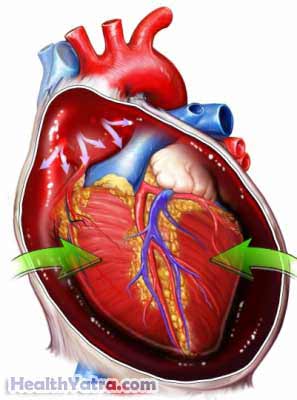Definition
Cardiac tamponade occurs when fluid builds up between the heart muscle and the surrounding tissue called the pericardium. This fluid compresses the heart. Because of this, enough blood cannot be pumped in and out of the heart.
This condition can be life-threatening. With proper treatment, the prognosis is good. Cardiac tamponade can return after treatment, though.

Causes
Cardiac tamponade can be caused by a variety of factors and conditions, including:
- Pericarditis —an inflammation of the sac that surrounds the heart, caused by bacterial or viral infections
- Bleeding into the pericardium, caused by injury
- Ruptured heart muscle
- Cancer in or near the heart
Risk Factors
These factors increase your chance of developing this condition. Tell your doctor if you have any of these risk factors:
- Heart surgery
- Tumors in the heart
- Heart attack
- Injury to the heart
- End-stage lung cancer
- Kidney failure
- Radiation therapy to the chest
- Hypothyroidism
- Systemic lupus erythematosus
Symptoms
Symptoms vary from mild to severe. They typically include one or more of the following:
- Fatigue or drowsiness
- Shortness of breath, rapid breathing, or difficulty breathing
- Dizziness or light-headedness
- Chest pain:
- That extends to the neck, shoulders, or abdomen
- Sharp or stabbing pain
- Pain that is worsened by coughing or deep breathing
- Discomfort that can be relieved by sitting upright or leaning forward
- Swelling of the abdomen, veins in the arms or legs, or other areas
- Pale skin, or skin that is blue- or gray-tinted
- Rapid heartbeat
- Anxiety or restlessness
- Fainting
- Feeling of weakness
- General discomfort
Diagnosis
Your doctor will ask about your symptoms and medical history. A physical exam will be done. If you have a significant change in blood pressure between breaths, this is one way your doctor will diagnose this condition.
- Your doctor may need images of your bodily structures. This can be done with:
- Chest x-ray
- Echocardiogram
- CT scan
- MRI scan
- Coronary angiography
- Your doctor may need to test your heart activity. This can be done with:
- Cardiac catheterization
- Electrocardiogram (ECG, EKG)
Treatment
This is a serious condition. It can be life-threatening and requires immediate hospitalization and treatment.
Treatments are given to:
- Save the patient’s life
- Improve heart function
- Relieve symptoms
Treatments that are given for cardiac tamponade include:
- Pericardiocentesis —a procedure to drain the fluid around the heart
- Fluids to maintain normal blood pressure
- Antibiotics
- Medications to help increase blood pressure to normal levels
- Oxygen to reduce workload on the heart
- Surgery to remove or cut part of the pericardium
If you are diagnosed with cardiac tamponade, follow your doctor’s instructions .
Prevention
This condition usually cannot be prevented. However, understanding the risk factors can aid in prevention.
